Stress prediction based on biometrics data¶
Author: James Twose Date: 20-03-2021
This dataset comprises of heart rate variability (HRV) and Electrodermal activity (EDA) computed from the SWELL1 and the WESAD2 datasets. It comprises of the following three directories and sub-directories: 1) interim —contains the intermediate data that has been transformed directly from the raw datasets. The raw datasets are not included but they can be obtained from their respective publishers. This folder contains the following major contents: - a) Labels —the ground truth of the experiments. For the details of how these were obtained, please refer to the papers included in the root of this director. - b) eda —the raw eda signals - c) rri —the inter-beat (RR) interval extracted from the electrocardiogram (ECG) signal 2) processed —containes files that were computed from those in the intermidiate directory facilitate the analysis
final —files that were used for creating the model. This directory contains two sub-directories:
datasets —contains the combined train, test a nd validation data used to create the model. For more details refer to section II of the paper ”The influence of person-specific biometrics in improving generic stress predictive models”
results —contains the detailed results published in ”The influence of person-specific biometrics in improving generic stress predictive models”
Targets:¶
NASA-TLX for the SWELL
SSSQ for the WESAD
Import all necessary packages and functions¶
[66]:
# utility packages
import sys
import os
import glob
from sinfo import sinfo
# import warnings
# data manipulation packages
import pandas as pd
# from pandas.io.json import json_normalize #package for flattening json in pandas df
# from ast import literal_eval
import numpy as np
# plotting packages
import matplotlib.pyplot as plt
import matplotlib.patches as patches
import seaborn as sns
# analysis packages
from sklearn.preprocessing import MinMaxScaler
from sklearn.feature_selection import VarianceThreshold
from jmspack.NLTSA import ts_levels
# internal script
from extras import (swell_eda_features_cols,
swell_eda_target_cols,
variance_threshold,
nunique_threshold)
[11]:
sinfo(write_req_file=False)
-----
extras NA
jmspack 0.0.2
matplotlib 3.3.4
numpy 1.19.2
pandas 1.2.3
seaborn 0.11.1
sinfo 0.3.1
sklearn 0.23.2
-----
IPython 7.21.0
jupyter_client 6.1.7
jupyter_core 4.7.1
jupyterlab 3.0.10
notebook 6.2.0
-----
Python 3.8.8 (default, Feb 24 2021, 13:46:16) [Clang 10.0.0 ]
macOS-10.16-x86_64-i386-64bit
12 logical CPU cores, i386
-----
Session information updated at 2021-03-21 15:35
Read in data¶
[142]:
# df_names_list = glob.glob("dataset/1. processed/eda/swell/*.xlsx")
# df = pd.DataFrame()
# for df_name in df_names_list:
# current_df = pd.read_excel(df_name)
# current_df["user_id"] = int(df_name.split("/")[-1].split(".")[0][1:])
# df = pd.concat([df, current_df], axis=0)
# df = (df
# .sort_values(["user_id", "Time"])
# .loc[:, ["user_id"] + [x for x in df.drop("user_id", axis=1).columns.tolist()]]
# .reset_index(drop=True)
# )
# df.to_csv("swell_eda_all_participants.csv")
df = pd.read_csv("swell_eda_all_participants.csv",
index_col=0)
[170]:
df.shape
[170]:
(104053, 37)
[143]:
df.info()
<class 'pandas.core.frame.DataFrame'>
Int64Index: 104053 entries, 0 to 104052
Data columns (total 37 columns):
# Column Non-Null Count Dtype
--- ------ -------------- -----
0 user_id 104053 non-null int64
1 Time 104053 non-null float64
2 MEAN 104053 non-null float64
3 MAX 104053 non-null float64
4 MIN 104053 non-null float64
5 RANGE 104053 non-null float64
6 KURT 104053 non-null float64
7 SKEW 104053 non-null float64
8 MEAN_1ST_GRAD 104053 non-null float64
9 STD_1ST_GRAD 104053 non-null float64
10 MEAN_2ND_GRAD 104053 non-null float64
11 STD_2ND_GRAD 104053 non-null float64
12 ALSC 104053 non-null float64
13 INSC 104053 non-null float64
14 APSC 104053 non-null float64
15 RMSC 104053 non-null float64
16 MIN_PEAKS 104053 non-null float64
17 MAX_PEAKS 104053 non-null float64
18 STD_PEAKS 104053 non-null float64
19 MEAN_PEAKS 104053 non-null float64
20 MIN_ONSET 104053 non-null float64
21 MAX_ONSET 104053 non-null float64
22 STD_ONSET 104053 non-null float64
23 MEAN_ONSET 104053 non-null float64
24 condition 104053 non-null object
25 Valence 104053 non-null int64
26 Arousal 104053 non-null int64
27 Dominance 104053 non-null int64
28 Stress 104053 non-null float64
29 MentalEffort 104053 non-null float64
30 MentalDemand 104053 non-null float64
31 PhysicalDemand 104053 non-null float64
32 TemporalDemand 104053 non-null float64
33 Effort 104053 non-null float64
34 Performance 104053 non-null float64
35 Frustration 104053 non-null float64
36 NasaTLX 98494 non-null float64
dtypes: float64(32), int64(4), object(1)
memory usage: 30.2+ MB
Exploratory Data Analysis (EDA)¶
[157]:
TARGET = "NasaTLX"
[158]:
df[swell_eda_features_cols] = pd.DataFrame(MinMaxScaler()
.fit_transform(
df[swell_eda_features_cols]
),
columns=swell_eda_features_cols)
[159]:
target_df = (df[["user_id"]+swell_eda_target_cols]
.groupby(["user_id", "condition"])
.mean()
.reset_index()
)
[175]:
_ = plt.figure(figsize=(30, 5))
_ = sns.scatterplot(x="user_id",
y=TARGET,
hue="condition",
data=target_df)

[179]:
target_df.groupby("user_id").count()[TARGET].value_counts()
[179]:
2 8
3 8
4 5
0 1
Name: NasaTLX, dtype: int64
[167]:
target_df.groupby("condition").describe()[TARGET]
[167]:
| count | mean | std | min | 25% | 50% | 75% | max | |
|---|---|---|---|---|---|---|---|---|
| condition | ||||||||
| interruption | 18.0 | 55.448197 | 15.246596 | 26.1 | 47.6500 | 54.123876 | 66.85 | 84.319786 |
| no stress | 21.0 | 55.209524 | 13.978838 | 26.1 | 46.0000 | 57.500000 | 63.70 | 81.300000 |
| resting | 6.0 | 56.391667 | 20.356827 | 26.1 | 47.4625 | 54.975000 | 68.75 | 84.000000 |
| time pressure | 15.0 | 55.666227 | 17.349646 | 27.6 | 44.7500 | 57.300000 | 62.00 | 92.600000 |
[115]:
# plot_df = (df
# .loc[df["user_id"] == 1, ["user_id"]+swell_eda_features_cols]
# .sample(frac=0.05, random_state=69420)
# .melt(id_vars="user_id"))
# _ = plt.figure(figsize=(20, 5))
# _ = sns.histplot(x="value",
# hue="variable",
# data=plot_df,
# bins=20,
# kde=True)
# _ = sns.kdeplot(x="value",
# hue="variable",
# data=plot_df
# )
[131]:
variance_summary = variance_threshold(df[swell_eda_features_cols], threshold=0.01)
[136]:
variance_summary[~variance_summary["discard"]]
[136]:
| variance | feature_type | discard | |
|---|---|---|---|
| MAX | 0.010415 | float64 | False |
| RANGE | 0.010208 | float64 | False |
| KURT | 0.016189 | float64 | False |
| SKEW | 0.015628 | float64 | False |
| ALSC | 0.042752 | float64 | False |
| INSC | 0.014582 | float64 | False |
| MAX_PEAKS | 0.011252 | float64 | False |
| MAX_ONSET | 0.011303 | float64 | False |
[130]:
# nunique_threshold(df[swell_eda_features_cols], threshold=1500)
[171]:
feature_selection = variance_summary[~variance_summary["discard"]].index.tolist()
# feature_selection = swell_eda_features_cols
for user in df["user_id"].unique().tolist():
print(user)
ts_df = df.loc[df["user_id"] == user, feature_selection + ["Time", "condition"]]
all_ts_levels = pd.DataFrame()
for column in feature_selection:
ts_levels_df, fig, ax = ts_levels(ts=ts_df[column],
ts_x=None,
criterion="mse",
max_depth=10,
min_samples_leaf=15,
min_samples_split=2,
max_leaf_nodes=30,
plot=False,
equal_spaced=True,
n_x_ticks=10)
_ = ts_levels_df.set_index("t_steps", inplace=True)
ts_levels_df.columns = [f"{column[1:]}_{x}" for x in ts_levels_df.columns.tolist()]
all_ts_levels = pd.concat([all_ts_levels, ts_levels_df], axis=1)
plot_df = (pd.merge(ts_df["Time"].reset_index(drop=True),
all_ts_levels,
left_index=True,
right_index=True)
.melt(id_vars="Time"))
try:
plt.figure(figsize=(30, 10))
height=1
ax = sns.scatterplot(x="Time",
y="value",
hue="variable",
palette="gist_rainbow",
data=plot_df[plot_df["variable"].str.contains("original_ts")],
legend=False,
linestyle='dashed',
)
ax = sns.lineplot(x="Time",
y="value",
hue="variable",
palette="gist_rainbow",
data=plot_df[plot_df["variable"].str.contains("ts_levels")],
)
_ = ax.set(xlabel='Time', ylabel='EDA',
title=f'Different Electro Dermal Activity ts-levels for user == {user}')
for condition in ts_df["condition"].unique().tolist():
x_index = ts_df.loc[ts_df["condition"] == condition, "Time"].index.tolist()[0]+1
x_co = ts_df.loc[x_index, "Time"]
width = ts_df.loc[ts_df["condition"] == condition, "Time"].max() - x_co
_ = ax.add_patch(patches.Rectangle((x_co, 0), width, height, alpha=0.2, facecolor="#581845"))
_ = plt.text(x=x_co + 0.4*width, y=1.005, s=condition)
_ = plt.show()
except:
print(f"User == {user} plotted with errors")
1

2
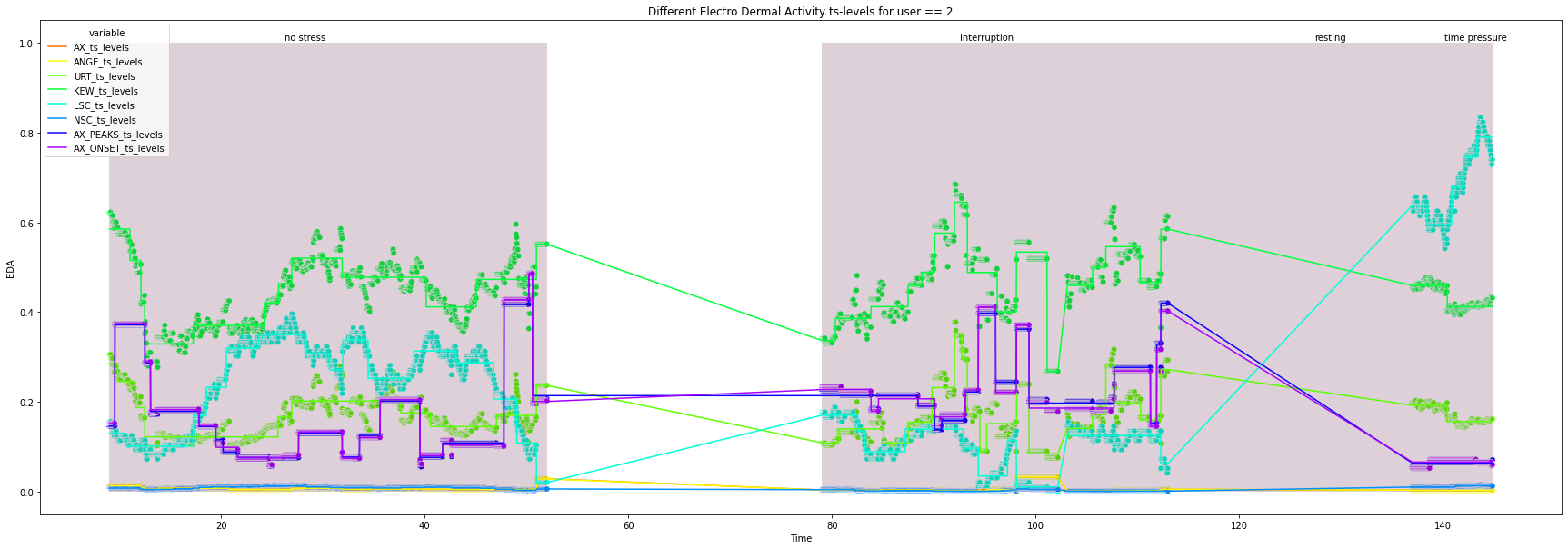
3
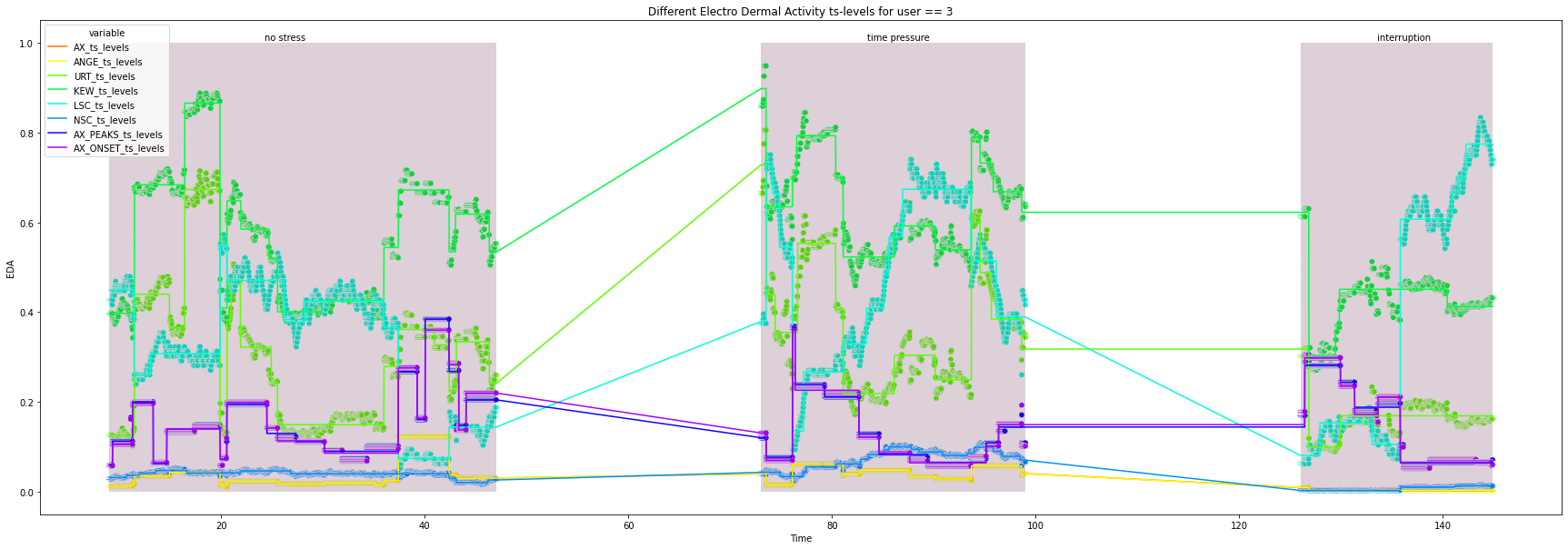
4

5

6
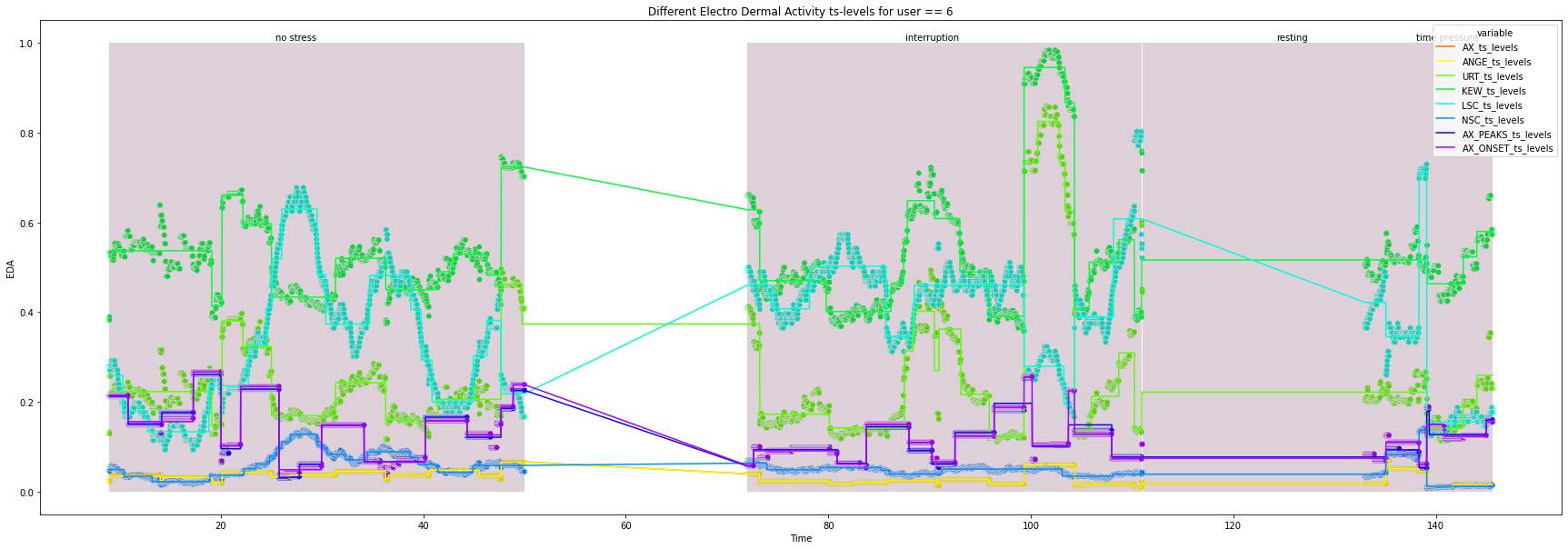
7

9
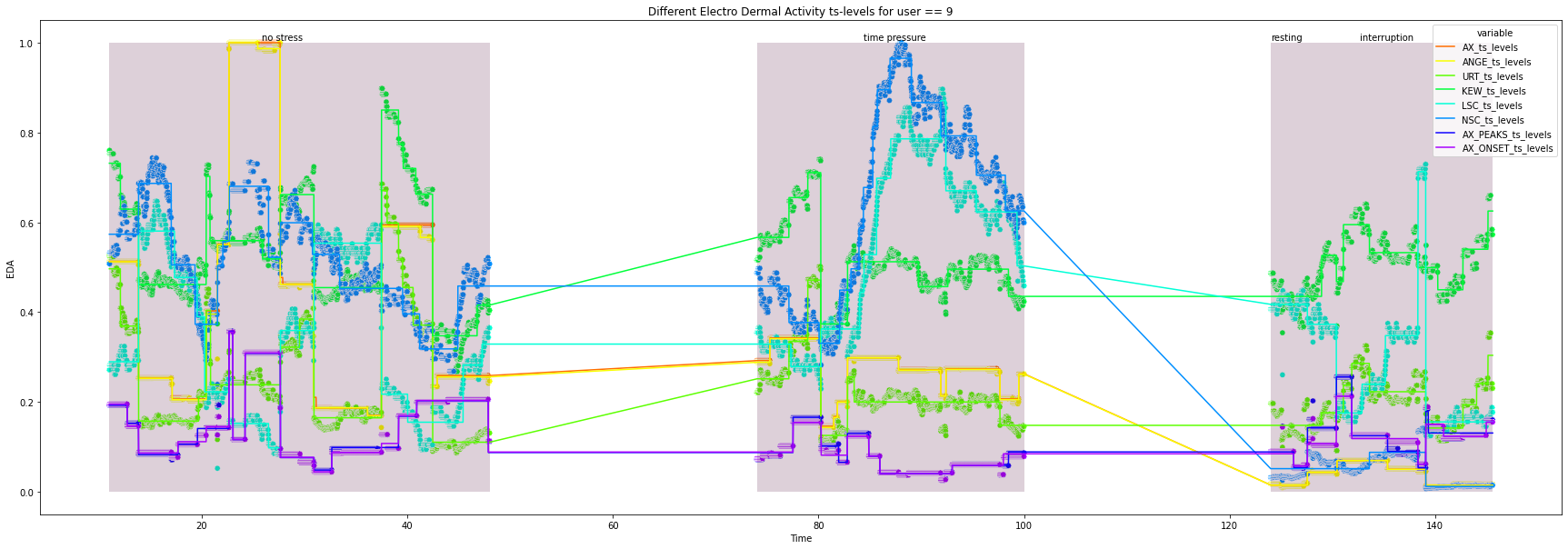
10
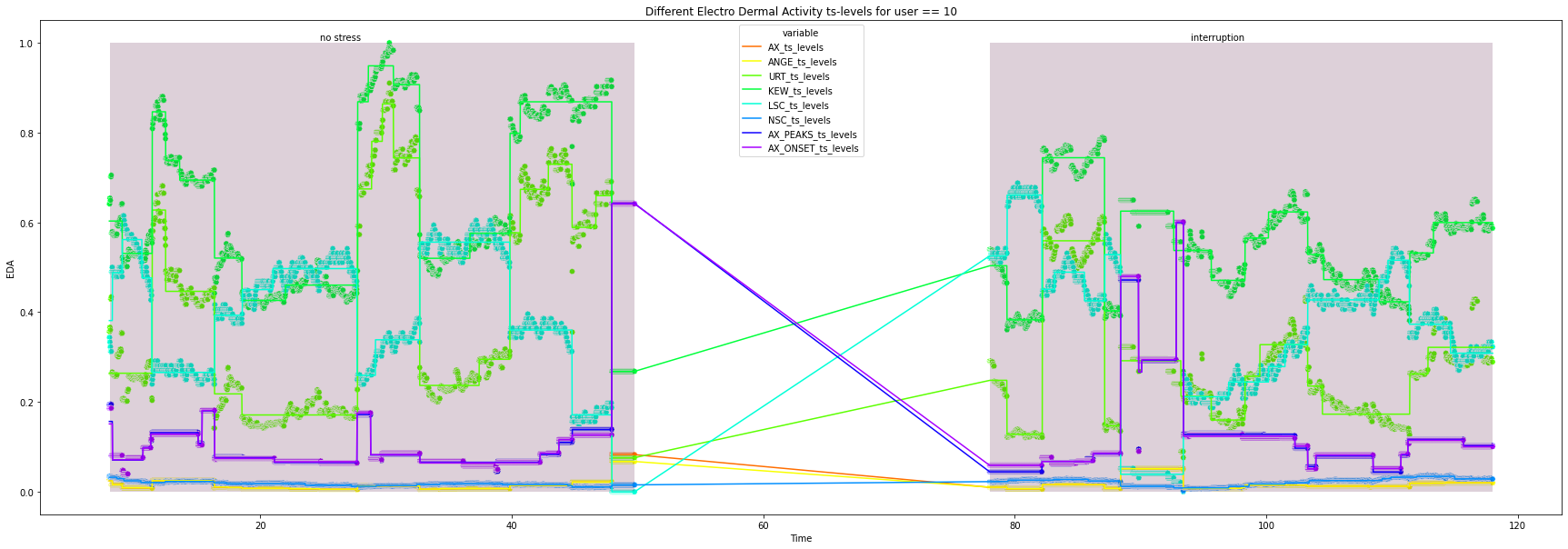
12
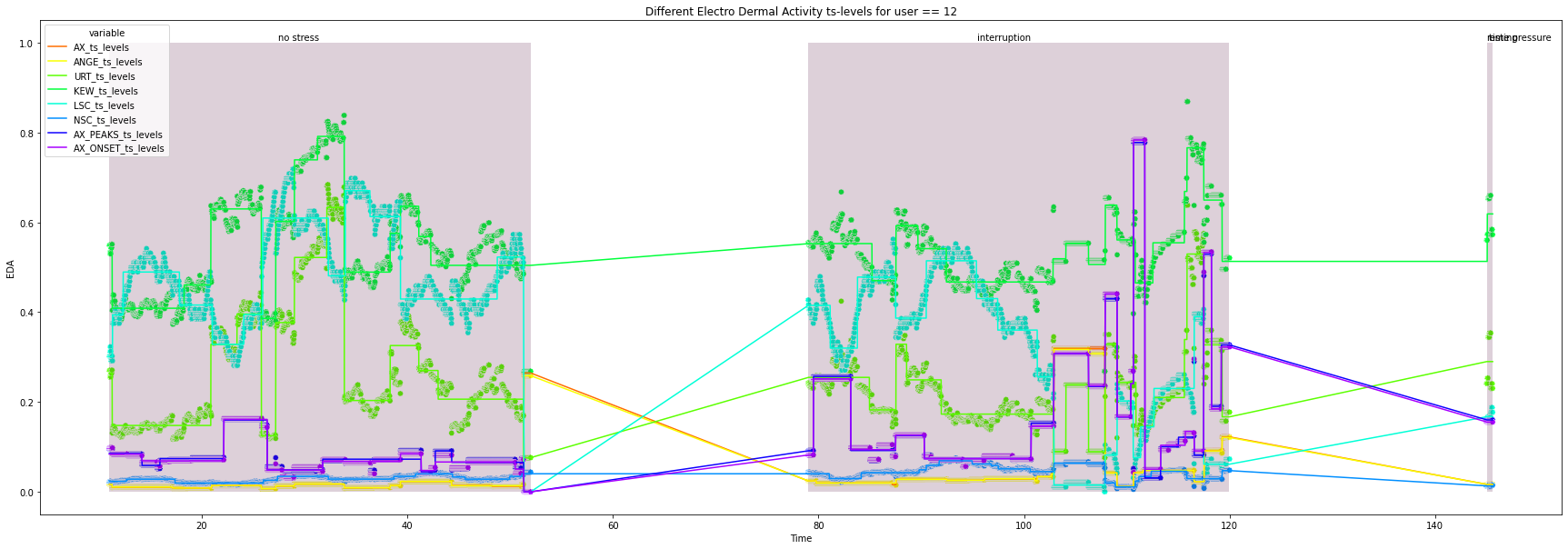
13
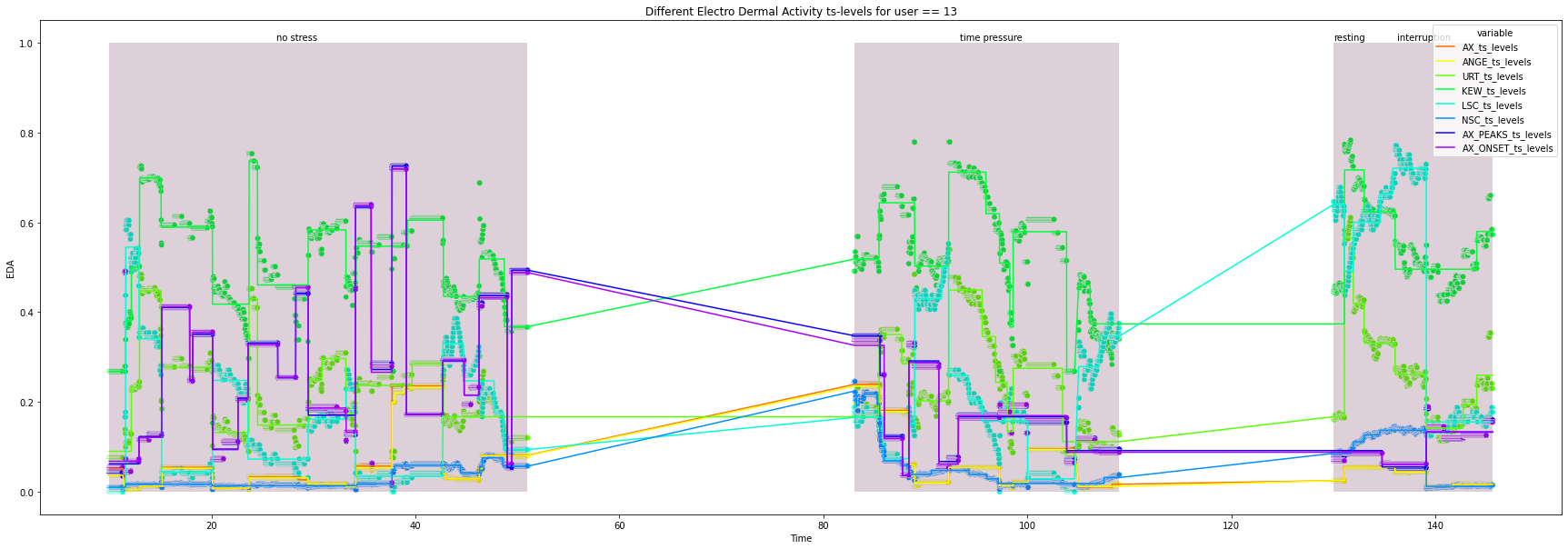
14
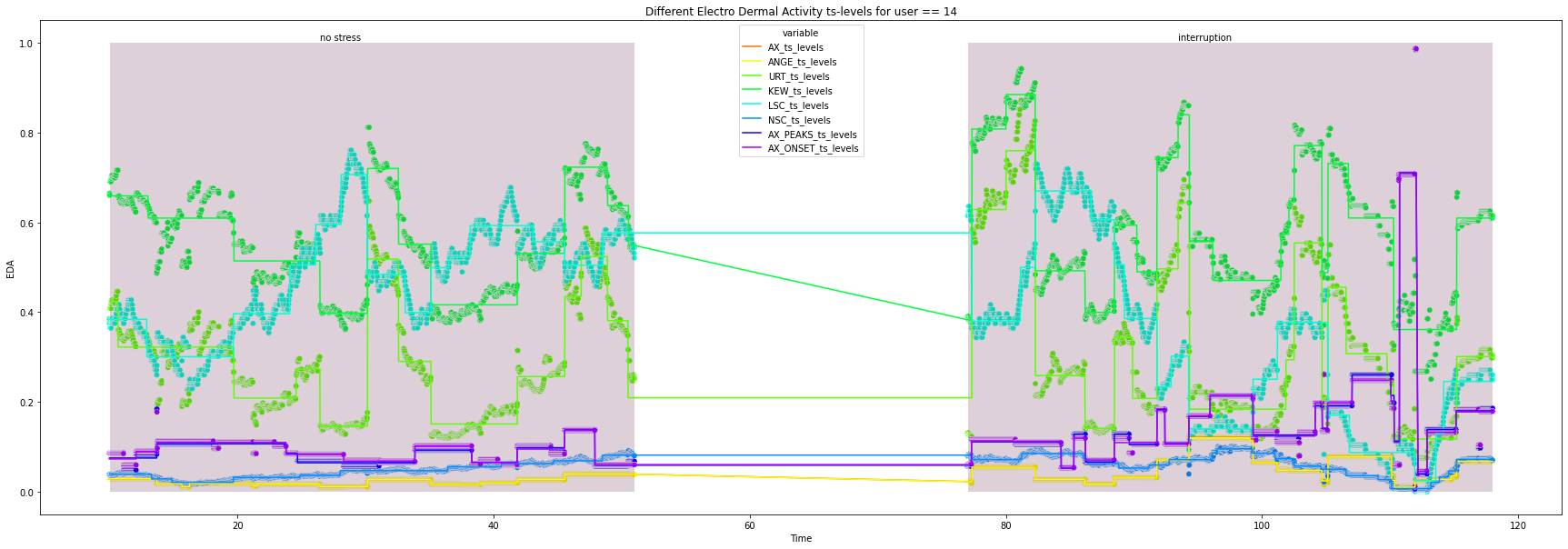
15
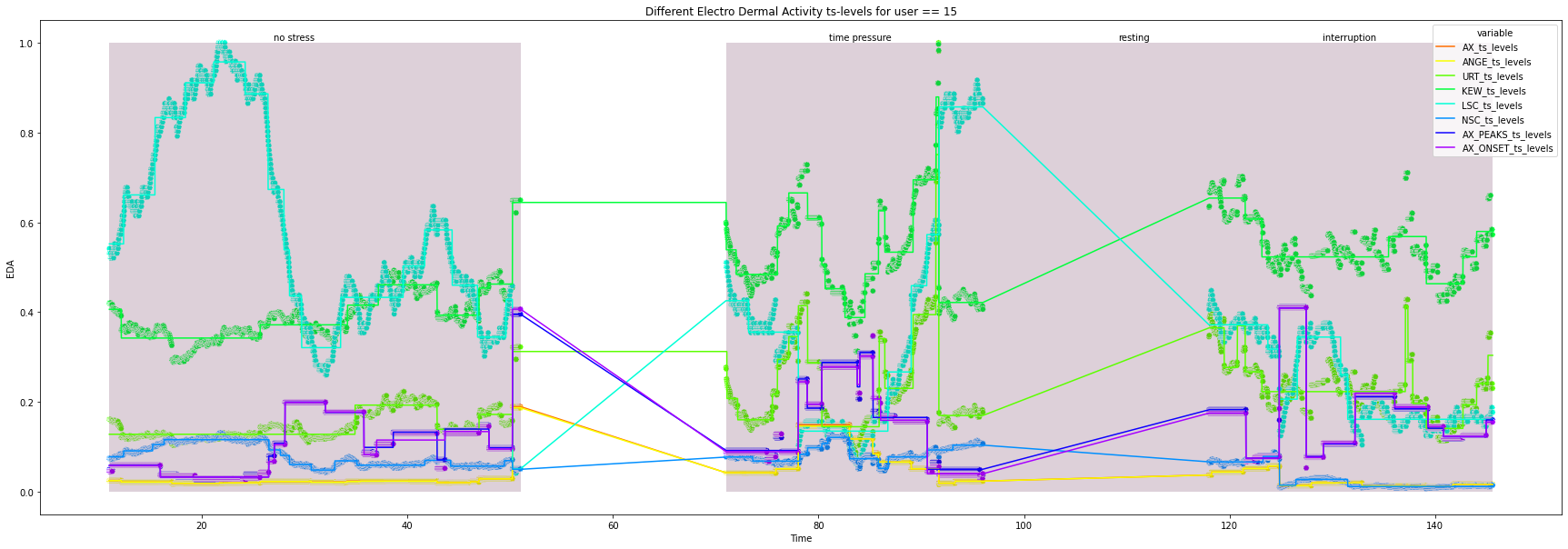
16
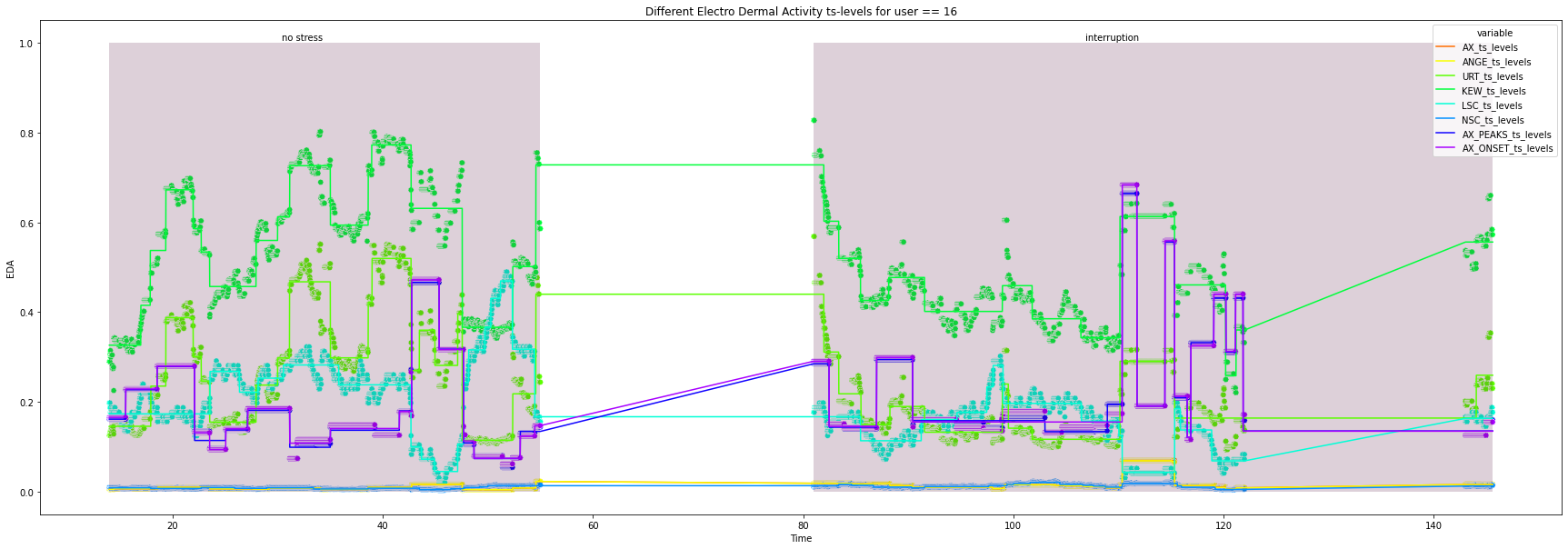
17
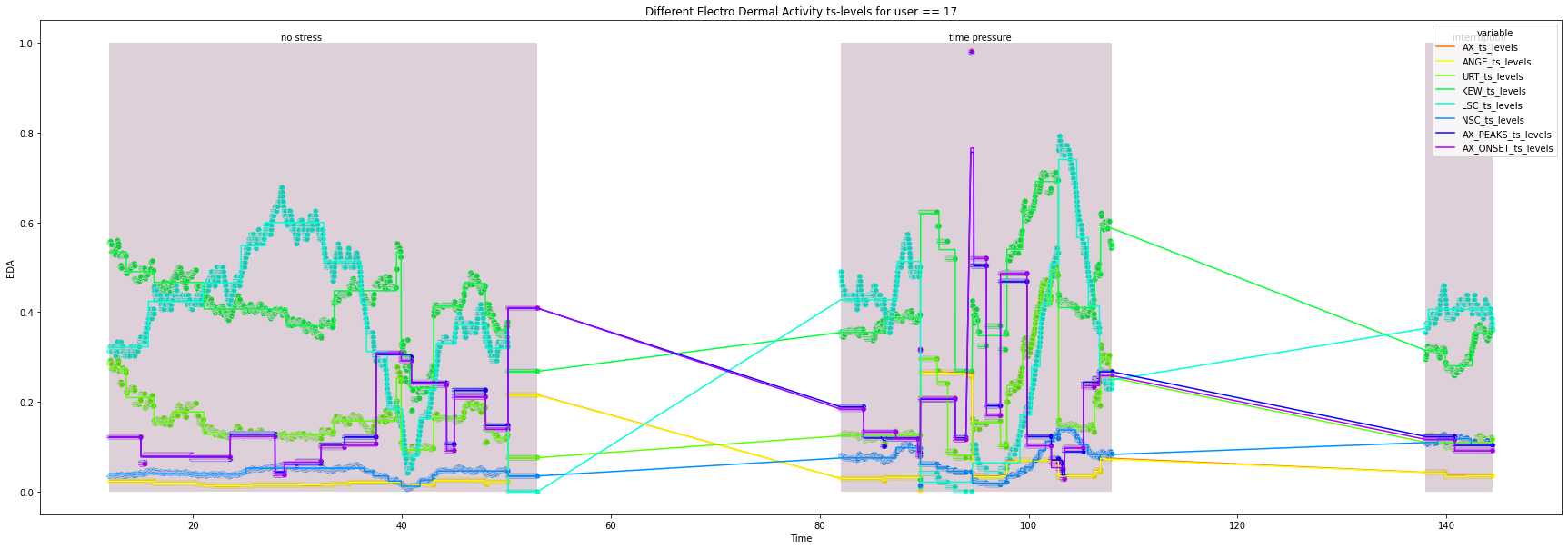
18
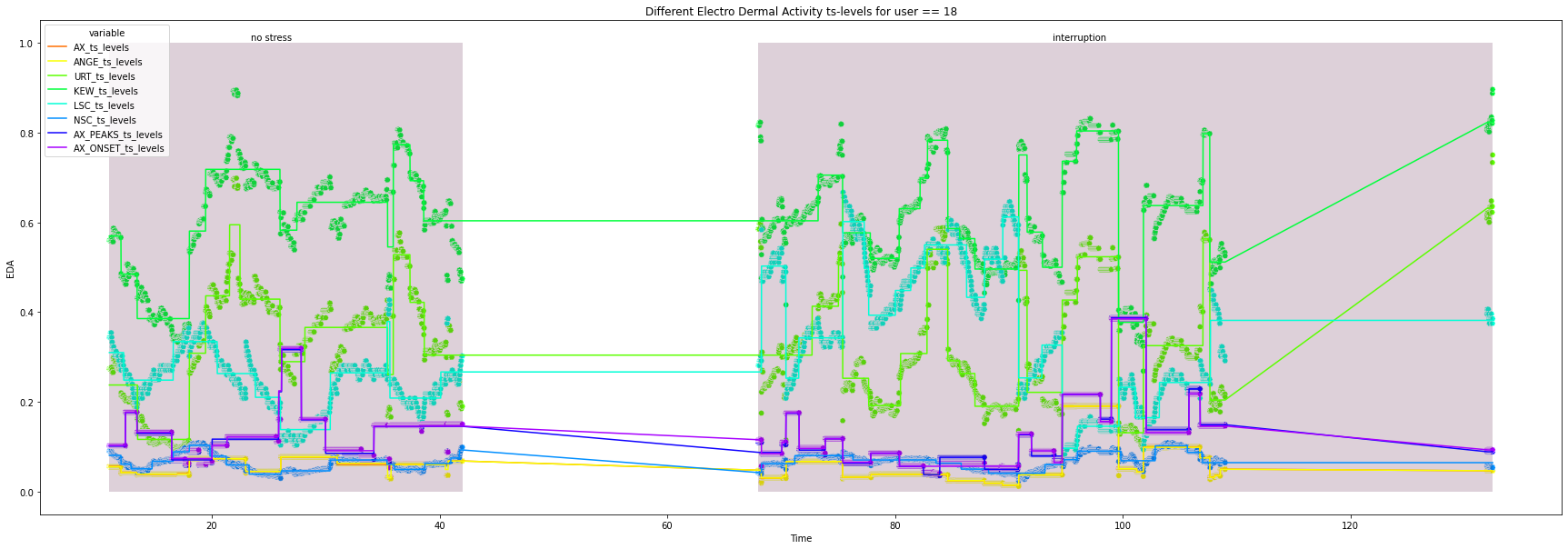
19

20
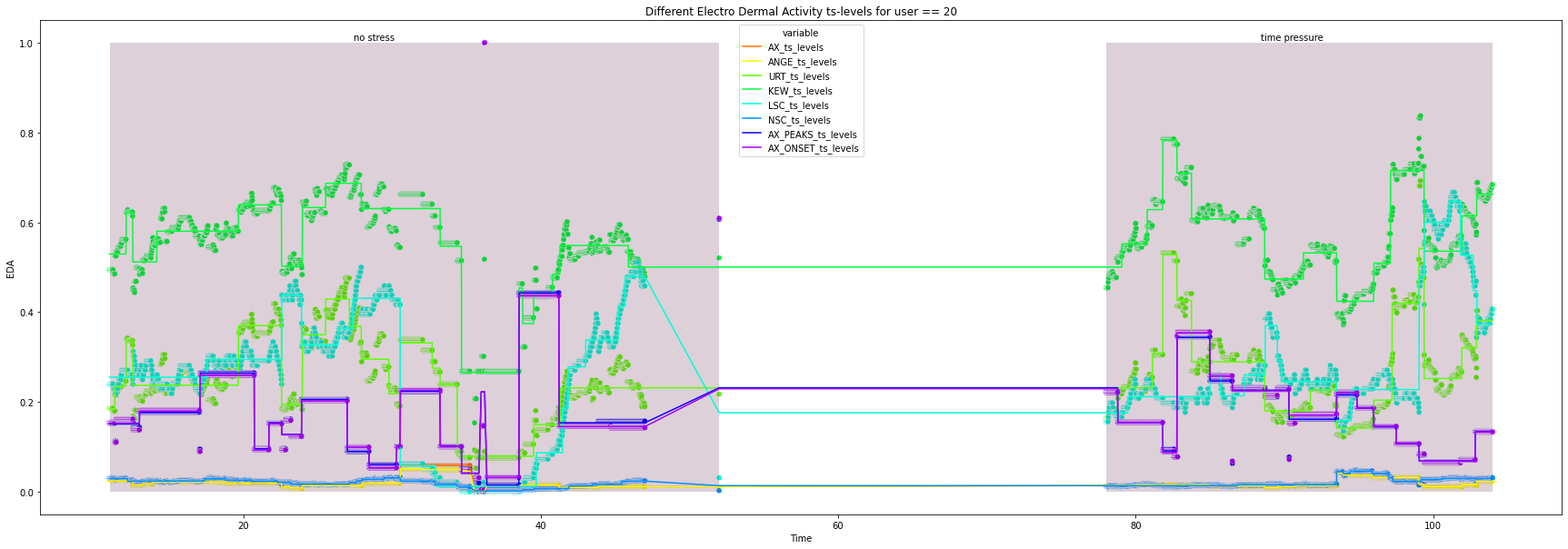
21
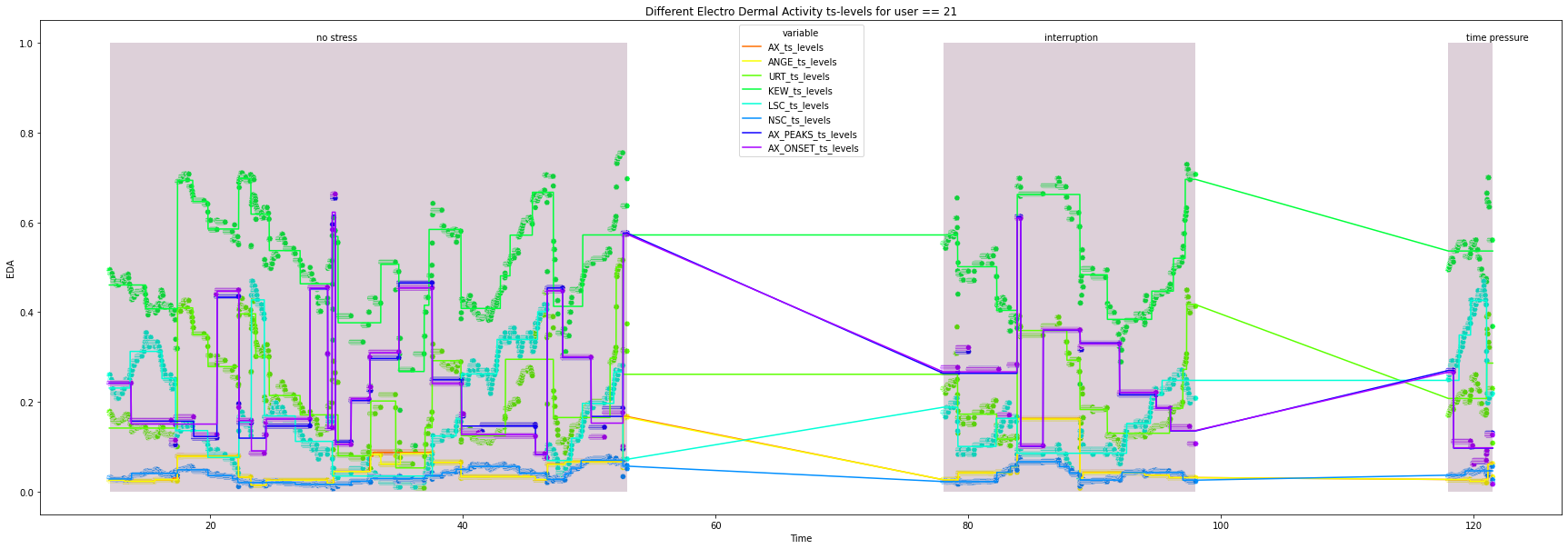
22
User == 22 plotted with errors
24
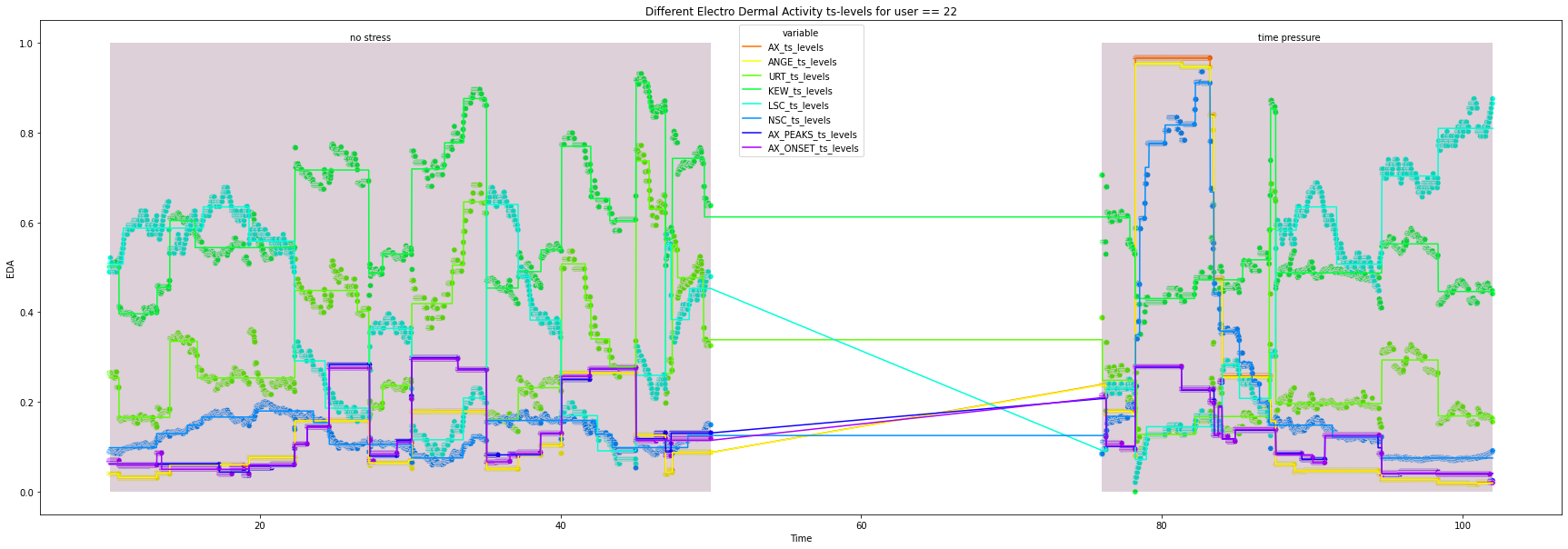

25

[ ]: